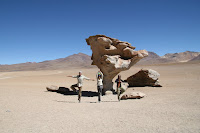

In the last months of my service, I spent July working with Pro Mujer in the largest department of Bolivia, Santa Cruz. Their rural credit program is based out of 2 intermediary centers in Ascencion de Guarayos and San Ignacio, 6 and 12 hours outside Santa Cruz city, respectively. I worked with the staff on training and ran a diagnostic on community priorities for business and health services. We went to tiny, beautiful towns reached only by motorcycle and sometimes cramped public minibuses, where the women delightedly shared their chicha de mani and let me swing in their hammocks while we talked. I wish I had more time to work with them and be in those towns.
My runs were on coppery sand roads through flat grassy estancias and thick patches of palm trees, with squawking parrots and reproachful cattle. Even in the early morning the heat and humidity were strong. I ate a lot of yucca and discovered fried cunape (as if cunape could get any better!).
In August I resumed working with the Centro Solidario, a state home for juvenile delinquents. Our last project was to paint a world map mural, which is what we were doing when I got the call from Peace Corps to evacuate. Like most volunteers I disappeared overnight, without time to say goodbye or explain to my friends, family, co-workers. In Lima I waded through the necessary reports, paperwork, and medical tests to finish my service. At the first modern mall I have seen for years, I found out I can eat half a Pizza Hut pie and 7 Dunkin Donut holes in about 12 minutes.



On September 22 I officially closed service. There is quite a migration back to Bolivia. There are 6 of us in the first group to go back; 4 buses in 30 hours straight and sunset on Lake Titicaca is Bolivia's welcome home to us. Today we finished our World Map Project. I have said my goodbyes and packed my things. Next week I go to Tarija where I will leave Bolivia for Argentina, then home. I can't wait to see everyone, who sent the e-mails, mail, thoughts & support that meant so much to me these last 2 years. Thanks & happy travels.





 We continue on to my anxiously-planned Tour de Sucre. Sucre graciously humors me with the impossibly blue, blue skies and dazzling sunshine I had hoped to present the White City in. Saturday is Día de los Niños y Niñas so we go to the party at my orphanage. I am “madrina” of the cake, which involves balancing a drum-sized cake on my knees while at the mercy of the driving of a Bolivian taxista. Absolutely terrifying. Bolivians always march around carrying entire cakes from the market on a skinny piece of styrofoam. They make it look so easy.
We continue on to my anxiously-planned Tour de Sucre. Sucre graciously humors me with the impossibly blue, blue skies and dazzling sunshine I had hoped to present the White City in. Saturday is Día de los Niños y Niñas so we go to the party at my orphanage. I am “madrina” of the cake, which involves balancing a drum-sized cake on my knees while at the mercy of the driving of a Bolivian taxista. Absolutely terrifying. Bolivians always march around carrying entire cakes from the market on a skinny piece of styrofoam. They make it look so easy. 


 It is blinding and immense, not soft like the snow it appears to be, and etched into an eccentric patchwork quilt by the ridges left behind by water that rises to the surface. It doesn’t crumble easily; there are no footprints. The salt burns my chin where I’ve been resting my head on the ground to take perspective pictures of us popping out of wine bottles and hugging giant iPods. The trip ends in the train graveyard, an unlikely (read: only in Bolivia) tourist attraction of silent giants, after 3 days of car games and an unhealthy number of lollipops.
It is blinding and immense, not soft like the snow it appears to be, and etched into an eccentric patchwork quilt by the ridges left behind by water that rises to the surface. It doesn’t crumble easily; there are no footprints. The salt burns my chin where I’ve been resting my head on the ground to take perspective pictures of us popping out of wine bottles and hugging giant iPods. The trip ends in the train graveyard, an unlikely (read: only in Bolivia) tourist attraction of silent giants, after 3 days of car games and an unhealthy number of lollipops.

























